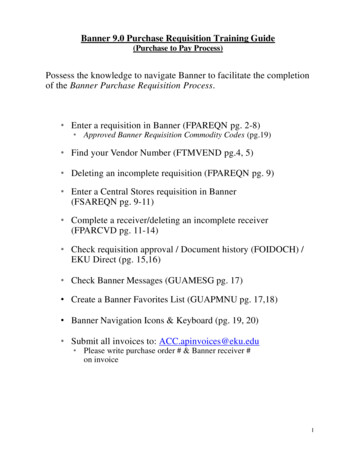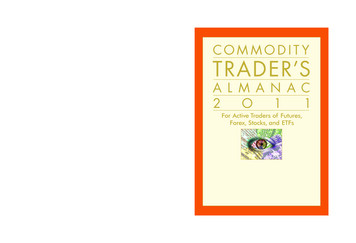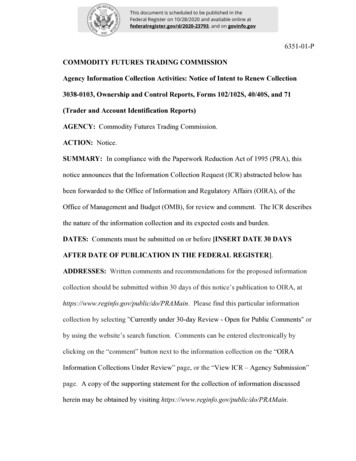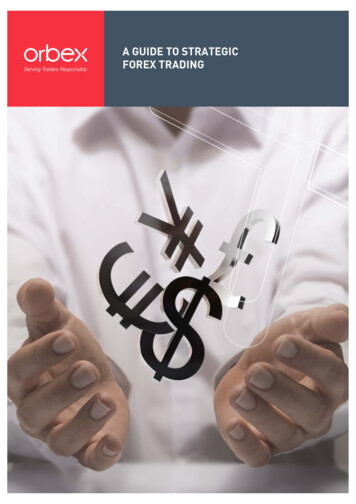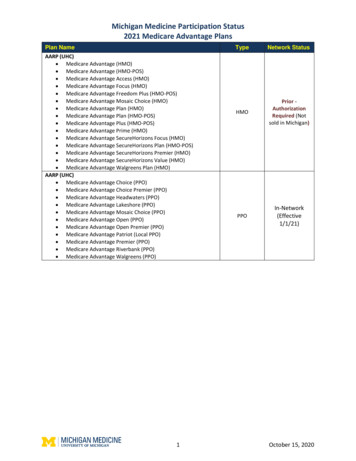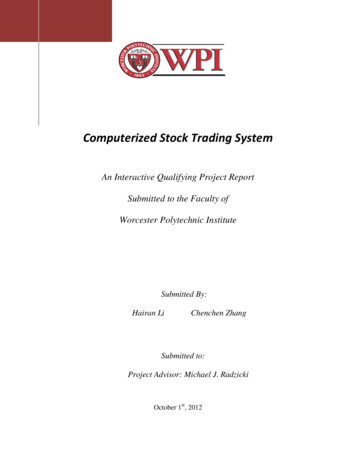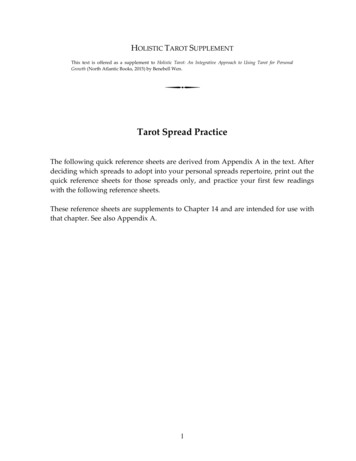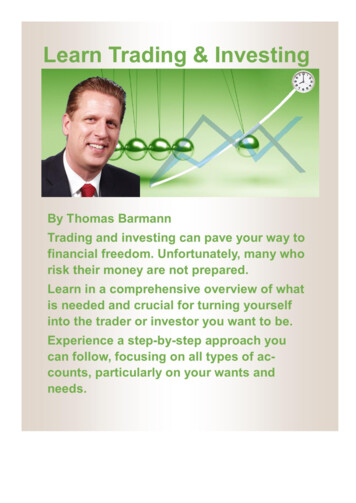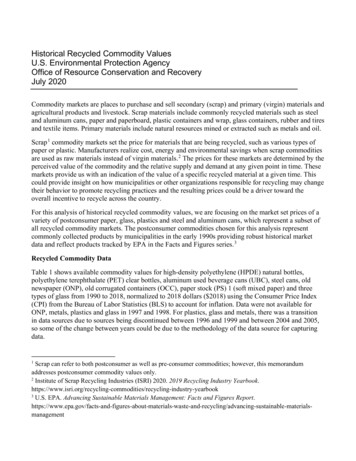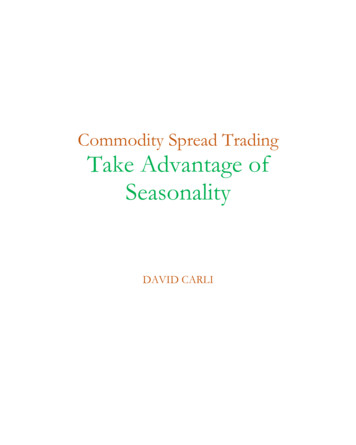
Transcription
Commodity Spread TradingTake Advantage ofSeasonalityDAVID CARLI
This book is sold with the understanding that neither the author nor the publisheris engaged in rendering legal, accounting, or other professional services or adviceby publishing this book. Each individual situation is unique. Thus, if legal orfinancial advice or other expert assistance is required in a specific situation, theservices of a competent professional should be sought to ensure that the situationhas been evaluated carefully and appropriately. The author disclaims any liability,loss, or risk resulting directly or indirectly, from the use or application of any ofthe contents of this book. There is a substantial risk of loss in commodity trading.It is not suitable for everyone.Copyright Eighth edition in January 2021 by David Carli.All rights reserved. This book or any portion thereof may not be reproduced orused in any manner whatsoever without the express written permission of thepublisher except for the use of brief quotations in a book review.First edition: 2016ISBN: 9798701176452Website: www.tradingwithdavid.comE-mail: info@tradingwithdavid.com
EDITEDCaroline Wintercarolinewinter4@hotmail.com
CONTENTSIntroduction – About the Author1Introduction – About SpreadCharts3Introduction – Preface5Chapter 1 – Birth of Commodity Market7Chapter 2 – Introduction to Commodity14Chapter 3 – Spread Trading24Chapter 4 – Fundamental Analysis34Chapter 5 – Statistical Databases39Chapter 6 – Not only Seasonality78Chapter 7 – Technical Analysis82Chapter 8 – Commodity Reports96Chapter 9 – The C.O.T. Report109Chapter 10 – FPD, FND and LTD124Chapter 11 – Money Management130
Chapter 12 – Value-at-Risk (VaR)137Chapter 13 – The Term-Structure147Chapter 14 – Multi-Leg Spreads158Chapter 15 – Contango & Backwardation171Chapter 16 – The Starting Date180Chapter 17 – Exploit the Manipulation185Chapter 18 – The Open Interest190Chapter 19 – Subjective Probability204Chapter 20 – Crop Year215Chapter 21 – Final Comments218Appendix A – Joe Ross 1-2-3 Pattern227Appendix B – Commodity Summary232Appendix C – The Unit Move236Appendix D – FND and LTD239Appendix E – Month Symbols243Appendix F – Commodity Reports245Appendix G – Web Resources250Appendix H – Commodity Glossary255vi
ABOUT THE AUTHORINTRODUCTIONDavid Carli is an Italian trader and independent financial analyst. Hecompleted his studies at the University of Pisa, and has released several successfulbooks about trading. It is his success and knowledge that David wishes to pass onto other potential traders, helping them to avoid mistakes and succeed in thefinance and investment markets.After completing his studies at the University of Pisa, David attendedseveral exclusive trading courses run and organised by Steve Nison in the UnitedStates of America. David believes that the best person to manage your investmentsis yourself. Only you understand how long and hard you had to work to achieveyour savings. By helping you avoid the strategies that do not work, David hopes togive all traders a better chance at success.Since January 2007, David has been living and working as a full-timetrader. It was during 2007 that David began collaborating with several highlyplaced trading websites and magazines. During the financial crisis of 2008, Davidlearned the importance of diversification in trading, helping to achieve low-risk1
investments. David studied the best approach across all markets to achieve abalanced asset allocation of savings.In 2012 and 2013 David worked for a small Italian Fund, but inJanuary 2014 he left to manage his investments on a full-time basis. In 2018,David started to collaborate with an important European commodity investmentcompany.He is currently also working on several books for those that wish tolearn more about certain aspects of trading such as Forex, options, commodity andspread trading, stocks and more. David also teaches interested investors hispersonal trading strategies and how to apply them within different markets.He hopes that through books, courses, videos, and articles, people ntsectors.Onhttps://tradingwithdavid.com, you will also find David’s analyses and his tradesmade using his strategies. You will see that each aspect of his trades is always wellplanned and thought out.2
ABOUT SPREADCHARTSINTRODUCTIONSpreadCharts is a complete analytical platform for commodityfutures and spreads. Find out more on https://SpreadCharts.com.Seasonality alone is no longer sufficient in today's financial markets.It is like a rear-view mirror: it tells you something about the past but very littleabout the present. You have to do better to be successful in today's ever-changingmarkets. You need additional tools that work independently from seasonality andreflect what is happening in the market right now. You need SpreadCharts.SpreadCharts offers the widest range of functions, which gives you aunique insight into the markets. Technical analysis, seasonality studies,sentiment data, term structure dynamics. these are just a few of the many toolsyou will find in this app. And they are free for anybody to use, which is especiallyhelpful for beginners. Moreover, all of this is served in a modern, user-friendlyenvironment. You can run the app anywhere and anytime - on your PC, tablet, orphone if necessary.While the free features are great, the premium features onSpreadCharts will blow your mind. A good example is the trading signals powered3
by artificial intelligence. The intelligent model generating the signals takes othertypes of data into account, not just seasonality. It makes predictions in real-time,continually learns from new data, and adapts to the ever-changing marketenvironment.For those who desire a more personal approach, there is premiumresearch. It is world-class research of the best opportunities in the markets frompeople with a successful track record in the hedge fund industry.Although the premium features are exciting, they will not make asuccessful trader out of you. Their purpose is to save you time analysing tens ofmarkets, finding you only the best opportunities. The rest is, however, up to you.Only hard work and thorough study will bring you success. But you are lucky! Thisbook is precisely the right source for the start of your journey in the markets.Pavel HálaSpreadCharts.com4
PREFACEINTRODUCTIONEveryone has seen the movie “Trading Places,” at least once in theirlife; after all, it is a must during the Christmas holidays. The trade on pork belliesat the beginning; the orange juice report, with which the two starring actors, DanAykroyd and Eddie Murphy, take revenge on Duke cousins priceless!Wheat, coffee, orange juice not only you can use them to prepare adelicious breakfast, but you can also trade them for profit. Trading withcommodities is the most fascinating and intriguing way to trade, as it includes acharacteristic uncommon to any other market: seasonality.Spread trading is the best way to trade commodities and provides anexcellent opportunity to diversify your portfolio, reducing the risks. Balancing,covering and protecting the portfolio have to be the trader’s first goal.“Take Advantage of Seasonality” is the first volume of the series“Commodity Spread Trading.” This book is a real and complete course oncommodities and spread trading. You will learn aspects that you will not find inany other book or course, and they come from over 25 years of experience infinancial markets, even as a fund manager for a small Italian investment bank.5
Inside this book, you will find explained not only the statisticaldatabases and software for your analysis but also the main commodity reports,how to read the C.O.T., term structure, and why you have to be careful of the FirstNotice Day (FND) and Last Trading Day (LTD).And again, the importance of a correct reading of contango andbackwardation, understanding if a movement is driven by speculation or realreasons such as a drought or epidemic, and many other essential aspects.With “Take Advantage of Seasonality” you will learn a new andexciting way to trade. With its modest price, this book is my gift for all those whoaspire to become professional traders.For any question, do not hesitate to contact me at the e-mail addressinfo@tradingwithdavid.com, it will be my pleasure to answer all of you. Also, visitmy website https://tradingwithdavid.com, where you will find free articles,analyses, and books.6
BIRTH OF COMMODITY MARKETCHAPTER 1What is a commodity? It is a natural resource that can be subjected totransformation and sold. Commodities are essential elements for the creation ofother goods. They are the building blocks on which food and industrialproduction are based.The production and consumption of commodities depends on severalfactors, such the weather, with the seasons, but also by natural and artificialresources. The demand for commodities is influenced by several factors, suchas economic, but also by consumer habits.The Commodity market is the oldest in the world. It was bornwhen ancient peoples began to barter: ten oil amphorae for five measures ofwheat in ancient Rome.In all the squares of the world, until the nineteenth century, thefarmers (Producers) met the artisans and entrepreneurs (Hedgers) who boughtthe wheat for the mills, negotiating the price based on the quality and quantityoffered.7
Commodities now are traded on the physical market and, morefrequently, through exchanges. The first financial contract dates back to around1700, to the Dōjima Rice Exchange in Osaka, Japan. It was a necessity that beganin the 1730s when the price of rice plummeted across Japan. Samurai, whowere paid entirely in rice, needed a stable conversion into money.Today's commodity markets have originated from agricultural tradein the 19th century (the first contract to the Chicago Stock Exchange dates back to1864 with a contract on wheat).Both buyers and sellers wanted to limit the risks to which they weresubjected during the harvest. The buyers tried to defend themselves in case cropswere scarce, and therefore the prices were high; while sellers wanted aguaranteed price to sell their goods, protecting themselves in case of oversupplyand low prices. However, the level of standardisation concerning the quality anddelivery of products was very scarce, and there was no centralised storagelocation.It was founded rounded in 1848 by the Chicago Board of Trade(CBOT), who played an intermediary role between farmers and traders in thetrade of grains. It determined procedures for weighing and grading of grains andwas created a centralised market. It established in advance the prices of deliveriesto be made in the future, and this allowed buyers and sellers to limit the risk ofprice changes.The tulip maniaHowever, trading in commodities has not always been undertaken8
solely with the intent of limiting risks, but has often had speculative connotations.At the end of the 16th century, Holland developed a market dedicated to thetrade of tulips. Prices began to climb, attracting a wave of investors with littleunderstanding of the horticulture sector.The cultivation of tulips in the Netherlands began in the late 1500s,when bulbs, imported from Turkey, demonstrate toleration for Dutch weatherconditions. The combination of a new investment available on the market and aparticularly prosperous and flourishing era that allowed the continued expansionof the Dutch economy, very quickly propelling investors into entering this newmarket.Very rapidly tulips became a real asset, so much so that they weretraded on the exchanges of many Dutch cities and pushed investors towards thisinvestment; the demand for tulips grew to such an extent that they began to beconsidered luxury goods, a status symbol that could not be renounced.The speculative bubble, however, unlike what is commonly believed,did not actually start from the tulips, but their bulbs. The tulip bulbs began to beseen as safe future investments, and many investors started to sell propertiesto buy them, giving rise to a dramatic increase in their price (and, by default, eventhat of tulips). It was reported that an Utrecht brewer reached the point ofexchanging his brewery for three tulip bulbs.The so-called “futures” began to make their way in the financialworld. Not being the tulips in themselves to arouse the greatest interest forinvestors, but their bulbs, the merchants began to sell the bulbs that had just been9
planted, and in this way the “right on the bulbs” was negotiated.The buyer paid, therefore, a sum as an advance on the final price,paying the balance only upon delivery of the flowering bulb; this phenomenon didnot go unnoticed, so much so that in 1610 a royal edict tried to prevent the tradeof bulbs, but failed to stop it.Their trade became, therefore, a “trade under-the-table” that tookplace mainly in taverns, where all that was required from traders was to pay a“wine money”, a commission of 2.5% a trade, for a maximum of three florins.All of this was, therefore, external to the exchange (precisely sincethey were considered non-legal) and took place between the individualcounterparties. The trade in tulip bulbs continued to grow inexorably until1636, a date that may be representative of the culmination of the bubble.We can see in figure 1 below the price chart of the tulips fromNovember 1636 to February 1637.Figure 1 - Price chart of the tulips from November 1636 to February 163710
In 1636, an auction sold a tulip bulb at 6,000 florins (an unreasonablefigure considering that the average income of a Dutch family at the time wasabout equal to 150 florins per year). Like any speculative bubble, the priceincrease was bound pretty soon to end with a wave of sales and a strong price fall.The bubble of tulips burst at the start of 1637 and in this case thehistorical context also influenced a trend in the economy. The bubble burst, infact, following an auction in Haarlem with no bids, probably due (although thereare still numerous debates on this topic), to a possible outbreak of bubonic plaguethat frightened the population making it stay in their homes.From that moment on, euphoria gave way to panic, and investorsbegan to sell tulips for fear that they would no longer be required as before, thustrying to make profits before it was too late.The wave of sales was such that the price of the bulbs and tulipscollapsed dramatically, leading to the bankruptcy of numerous speculators. Thebusted bubble had left behind it a panorama of financial devastation and aneconomy now in ruins.Buyers were forced to honour tulip purchase contracts at prices tentimes greater than market ones, while sellers held rights on bulbs with the valueof one-tenth of the original.To avoid the worst, on February 24, 1637, the Dutch floristcorporation decided to convert all futures contracts (i.e. futures regarding tulipbulbs) into options contracts. In this way, the buyer was no longer legally obligatedto buy the bulbs, but could also choose not to buy them by paying, in place of the11
final price, only a penalty.No one knows today exactly how many people were involved in thismarket, but there is no doubt that a value well beyond the reasonable physicalvalue was attributed to tulips, with this episode having a considerable impact onthe local economy.The commodity markets todayMarkets can be used to reduce the risk of price fluctuations to whichyou may be exposed, or, on the contrary, to exploit these price movements to youradvantage. What was once considered coverage for suppliers and dealers incommodities, today enables more people to have access to these markets.In recent decades, these markets have attracted pension funds, hedgefunds, investment banks, other institutional investors and, increasingly, evenprivate investors.Commodities today play an important role in many investmentportfolios. The growing investment in them throughout the years has led to theintroduction of a broader range of tradable commodities and a greater variety ofinvestment methods.Moreover, in the XXI century, many commodities are also used inways other than traditional ones. Corn, for example, has traditionally been usedin the production of food and animal feed. But with the growing awareness of thepossible adverse effects on the environment produced by the consumption of12
fossil fuels, the so-called “soft commodities” such as corn are increasingly used inthe production of biofuels.These new uses and decreases in the supply of some commodities cancreate interesting dynamics of supply and demand, influencing prices.13
INTRODUCTION TO COMMODITYCHAPTER 2We find commodities every day on our tables, and even when they arenot foodstuffs, we use them daily. For this reason, the price of commodities willnever drop to zero (which can happen, for example, for a stock). That is because wewould never deprive ourselves of certain goods such as corn or wheat that we eatevery day and that feed the world.The cost of production determines the first fascinating aspect ofcommodities. I will give an example. Let’s take the wheat; it is a commoditywidespread all over the planet. We consume it every day; we find it, for example,in the form of bread. That means that there will always be someone willing toproduce it for a profit.Producing wheat, however, has a cost, and if the price of wheat is toolow and fails to compensate costs, the farmer would stop producing it. This wouldlead to a reduction in supply because there would be fewer farmers in the worldwilling to produce wheat. As a result, the price of wheat would begin to rise.So, if we know the production cost of a commodity, we can purchasethat commodity at a low price because we know that below a certain level, that14
particular commodity is no longer convenient to produce. All of this will affect theprice, due to the decrease in supply which would cause the price to rise. And, it isworth to emphasise this aspect, it would do so with very low risks.That is the first interesting aspect that only commodities can offer us.Let's see now what the reasons that underlie an investment in commodities are.1. Inflation. Commodities have, by their nature, a role of coverage andthey do it very well against inflation.Generally, when the demand for goods and services grows, the pricesof these goods and services also rise, and, of course, the prices of commodities thatare used in the production tend to increase as well.Since the commodity price increases during periods of prices rise,investment in this asset can provide the investor with coverage of the portfolioagainst the pressure of inflation. In even more difficult situations, such as duringthe geopolitical and macroeconomic upheavals, commodities have often provedmore robust than other instruments.2. Diversification. To diversify, protect and balance the portfolioshould be the first rules of every investor. Reduction of the risk always passesthrough the choice of instruments and different markets, and in this, thecommodities play an important role.It is well known that, very often, when the value of certain assetsdrops (e.g. equities or bonds), commodities provide very interesting returns forinvestors. That is why it is important to diversify.15
3. Seasonality. Only with commodities can we exploit a seasonality, acycle which repeats year after year. Just think about heating oil. It is clear that wewill have much larger consumption of it in winter, while it will be used a lot lessduring the summer. This is also the case with the production cycle of the crops,with planting and harvesting occurring every year.That is a statistical advantage that we only have in the commoditymarket: if we know in in advance the seasonality of a commodity, we cananticipate price movement. Just a few data are enough, some analysis, nothingcomplex and we can make very interesting profits from this market.Let us now go and see which commodities are the most treated andthat we can trade every day. I start by saying that there are two types ofcommodities:1. Soft, such as wheat, coffee, sugar and even livestock, are thosecommodities more easily influenced by external factors, such as climate orepidemics because they tend to deteriorate. The producers of soft commodities areoften involved in this kind of market, with interest to set the price of theirproducts.2. Hard, such as crude oil, gas, gold, copper, are materials that areextracted from the ground or produced by other natural resources. Even the hardcommodities may be affected by external factors, although to a lesser degree thansoft commodities, such as strikes and wars.More specifically, we can divide the principal commodities into five16
categories:Grains: corn, wheat (in all its varieties: winter or spring, soft or hard,etc.), soybean, soybean meal, soybean oil and oats.Soft: cotton, cocoa, coffee, sugar, orange juice and lumber.Meat: live cattle, feeder cattle and lean hogs.Metals: gold, silver, platinum, palladium and copper.Energy: crude oil, gasoline, heating oil and natural gas.Even with the five categories listed above, we can diversify ourportfolio, moving out in different sectors. We should not concentrate ourselves sowe diminish the risk of a single investment, for example, within grains but inmultilevel sectors such as energy and meat.There are other categories and commodities that I have not listed,because although investors expect a florid market in the coming years, all theclassical instruments needed to invest in these products are not yet available. Atthe moment, they can be treated only by Funds. An example is the ETFs on wateror hydrogen.We are, therefore, coming to the general control of commoditiesthrough financial products.Now, it is time to see what the different factors affecting thecommodity prices are.17
1. Supply and Demand. The supply/demand relationship determinesthe price of the exchange of goods and services. The commodities price reflectsexactly this law of the market.If the supply increases, but demand does not change, (think, forexample, the harvest of corn that has a higher than expected return and, then, witha more considerable amount of corn in the market), the price will tend to fall. Manyfarmers will be willing to undercut the price of their corn to try to find a buyer.If demand grows, but produces are not able to satisfy it (think of theeffects of an epidemic on cattle resulting in a sharp decrease of meat on themarket), then the price will increase because buyers will be willing to pay a higherprice for the amount of product needed.2. The weather. It can influence the price of commodities and affectproduction a lot. It is, in fact, often the only thing responsible for very strong pricemovements due to imbalances in the supply/demand relationship.Adverse weather conditions do not affect only crops such as wheat orcoffee, but all commodities. Just think about the price of oil after the passage of ahurricane, or to transportation blocked due to heavy snowfall and frost.3. Diseases and epidemic. Some external factors can cause the priceof a commodity to skyrocket, such as diseased crop or an epidemic that affectslivestock. Just like with adverse weather conditions, diseases and epidemics createimbalances in the supply/demand relationship because of a reduction in supplywhich, as a consequence, results in a strong movement of prices.Reason for this is that buyers predict that the future availability of a18
commodity could become scarce; thus, they increase the demand for thatcommodity. They are willing to pay more for it today than in the future.4. Economic and political factors. Prices of commodities are alsoaffected by the economic and political events of the countries that are producingor using that commodity. For example, political unrest in the Middle East oftencauses fluctuations in the futures price of oil due to uncertainties on the supplyside.Think, also, to the strike in the gold mines in South Africa, or theduties in some South American countries on exports of grains. So, political andeconomic instability of a country can influence the price of a commodity.5. Reports. They are essential and give us a picture of the situation ofcommodities in their various phases: production, demand, supply, etc. Even just achange in the size of land cultivated can cause a rise or drop in the price of a crop.The inventories and stocks showed by the reports affect the price of acommodity a lot. Like, for example, the Weekly Petroleum Status report that everyWednesday is released by the EIA (US Energy Information Administration) andthat provides information about the petroleum supply situation. The newinventories can influence the crude oil price strongly.6. U.S. Dollar. The prices of commodities are in dollars, so, the USdollar is their enemy. A rising dollar is anti-inflationary, so it applies downwardpressure on commodity prices. Similarly, a falling dollar will usually apply upwardpressure on commodity prices.19
Investing in commodities is very different from investing in stocksand other financial assets. With commodities, we are dealing with a physical good,and managing that physical good requires effort that stock investors do not haveto worry about.Another aspect that we can deduce from the list above is that thecommodity market is less easily manipulated than other financial marketsbecause price is affected by the weather, diseases, epidemics, political factors, etc.that cannot be manipulated.At this point, you are probably wondering: how can I invest incommodities? There are several ways to do it:1. Physical. The most obvious way to invest in commodities is bybuying the physical commodity itself. By owning a commodity, we will have directexposure to increases and decreases in its value, and we can sell it when we wantto convert it back to cash.However, most physical commodities involve significant logisticalproblems. With commodities like gold or silver, it is relatively simple to finddealers to sell our coins or bars, albeit often at a slight profit margin. Instead, it isa lot harder to take possession of 1,000 barrels of crude oil or 5,000 bushels ofsoybean. Because of those problems, owning physical commodities works wellonly in limited situations with specific commodities.2. Futures. They are derivatives. That is, their value derives preciselyfrom an index, a commodity etc which are linked by something called anunderlying. Investing in commodities via futures offers investors a way to get20
exposure to changing prices of commodities without having to take physicalpossession of them.Using futures contracts, we will never get to possess a commodity onwhich we are going to invest. A futures contract is an agreement to buy or sell acertain amount of a commodity in the future, with an established price that canfluctuate with market conditions.3. Spread Trading. With spread trading, we no longer work on singlefutures, but on the difference between two or more correlated futures. We movefrom being directional on the market with the futures to non-directional withspread trading. That is a crucial aspect.With spread trading, investors create a hedge of the position with asignificant reduction of the risk. They get several other advantages that tradingwith futures cannot offer. I will not add anything else; we will see spread tradingfurther in the next chapter.4. ETCs. The Exchange Traded Commodity (ETC) gives investorsexposure on commodities in the form of shares. Traded as a stock, i.e. bought andsold on a stock exchange, ETCs replicate the price movement of commodities, suchas oil, gold, silver, etc. and then fluctuate on the basis of the value of thosecommodities.ETCs can treat individual commodities or a commodity basket. Anexample of a commodity basket ETC is one that is composed of multiple metals(not only one), like gold, palladium, copper, etc. In this way, we have invested inmetals correlated with the growth of an economy (i.e. copper and aluminium) and,21
at the same time, we are covered with defensive assets like gold and silver.5. Equities. With equities, we are going to invest in shares ofcompanies linked to the world of commodities. Mining companies and oil and gasexploration and production companies have direct exposure to commoditiesprices. Affiliated businesses like heavy-equipment manufacturers and oilfieldservices companies tend to do better when the underlying is performing well.Unlike an ETC or ETF, we will invest in companies that work anindividual commodity, and this implies substantial differences. Furthermore,often the price of a share of a company can undergo significant fluctuations due toexternal and economic factors. The price of a commodity cannot fall to zero; theprice of a share, on the other hand, can.6. Options. They are contracts that give the holder the right to buy(call option) or sell (put option) a given quantity of an underlying financial asset(equities, futures, ETFs, etc.) at a specific price (the strike) and a date (or within adate). If I buy an option, I pay a premium; if I sell it, I get a premium.Just like with futures, options are also derivatives. But unlike futureswith which we promised to fulfil the contract, when we buy options, if we feel thatthe operation is no longer convenient for us, we are not obliged to fulfil thecontract, and we will only lose the premium we paid previously.For the second time during the reading of this chapter, you areprobably wondering: among all these, which is the better way to tradecommodities? We can, of course, use all the ways seen above. The best ones to tradecommodities, for many good reasons, is through the spread trading and options.22
For options, I refer you to my books “Options, from Theory toPractice – A Complete Guide for Beginners” that will give you a completeknowledge about Options a
Since January 2007, David has been living and working as a full-time trader. It was during 2007 that David began collaborating with several highly-placed trading websites and magazines. During the financial crisis of 2008, David learned the importance of diversification
